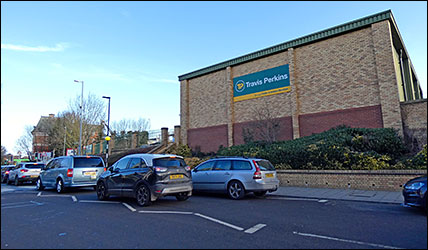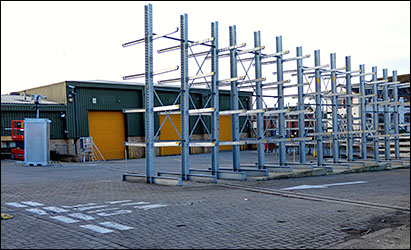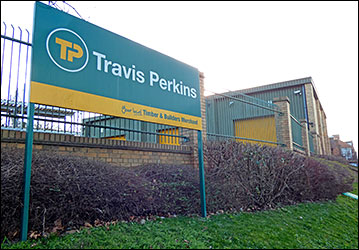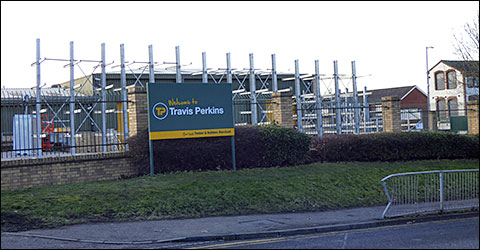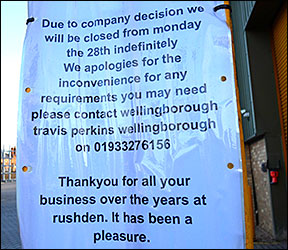|
||||||||||||
| Article and photos by Paul Wright, 2023 |
||||||||||||
|
From Ellis & Everard to Travis Perkins
|
||||||||||||
|
|
||||||||||||
Some people still enjoy the comfort and effect of a real fire these days, I suppose that number is really small compared to the numbers that were around in the 1950s and maybe in to the 1970s. These days it does seem to be in the shape of logs, which are then used in a so called ‘log burner’. But formerly the solid fuel of choice was coal or coke, and of course the coal was delivered by a lorry with big heavy canvas sacks on board, and a ton of coal was not an unusual amount to be deposited in to the ‘coal barn’. Or maybe the coal bunker? I seem to recall my late mother saying that it had just cost £20 for a ton to be delivered, that may have been in the early 1960s? And the coal man was called Dick Barrett? I was very young, and excuse me for having a patchy memory, but they were based in Moor Road? (sorry if I have got any of that wrong) Naturally this black gold was arriving in Rushden on the railway for so many years. But in the early 1960s Dr. Richard Beeching was appointed as head of British Rail and began his famous ‘cull’ of the railways. The line to Higham Ferrers was due for closure and despite several protests and petitions Rushden & Higham Ferrers Stations were closed to the public on 13th June 1959. Passenger services and the traditional August Bank Holiday excursions carried on until 1964. I do recall going on a special that was a mega day out, which was arranged by the social clubs in Rushden, it started at Rushden station and went all the way to Hunstanton for the day trip. Big crowds turned out to witness the passing of an era many taking that final trip on the line, the fare was 3d return to Higham Ferrers and Rushden. Goods trains still used the line, then the goods depot closed at Higham Ferrers, the station there followed suit on 3rd February 1969, with Rushden closing later in November 1969 with closure of the coal depot. The line from Rushden and Higham Ferrers went through to Wellingborough, and you can see remains of the line when driving from Rushden towards Ditchford, if you look to your left.
But don’t forget Rushden station is now the base for ‘Rushden Historical Transport Society’ (RHTS). Various coal companies used the coal depot at Rushden Station, and a name that sprung to mind was ‘Ellis and Everard’, they even had their name displayed on the big coal trucks that went up and down the Midland Main line from the collieries in the Midlands. You could also see a large sign above their depot close to railway station in Station Approach.
Although unlike today, the heavy coal trains would have been running up the “Goods line” as we called it, and these would be running day and night, taking fuel etc to London. The freight services were so heavy, that a deviation was cut via Wymington to allow the less powerful steam engines to have an easier journey. The Deviation starts, at its northern end, what was Irchester signal box, the mechanical boxes there and at Sharnbrook were closed in Dec 1987 and May 1981 respectively with the advent of the power signalling schemes. All the lines from St Pancras to just north of Sharnbrook are now controlled from West Hampstead in London, and the lines northwards from Leicester. The signal box at Souldrop was closed in Dec 1966, and the small signal box at Wymington in March 1963. Mr Walter White from Rushden Road in Wymington was one of the final signalmen on duty there. Mr Peter Butler covers this in more detail on this site. The arrival of electric trains locally, finally came over the weekend of 16th May 2021, although not all services are powered by electric, and diesel engines still ply their trade as I write this article in mid 2023. The name ‘Ellis and Everard’ cropped up in the mid 1840’s, and along with coal, they were a builders merchant, and were eventually based in Station approach. Northampton based Travis Perkins then took over the business, and completely refurbished the site.
But a big change came in the summer of 2020, when Travis Perkins sought to cut 2, 500 jobs under plans to close 165 branches during the Covid-19 pandemic in the United Kingdom. In that list of branch closures was Rushden, and their site in Station Approach shut in 2022. The largest distributor of building materials in the country, Travis Perkins plc has over 20, 000 colleagues in the UK and also in France, Belgium and the Netherlands through Toolstation. They are still based at Lodge Farm Industrial Estate, Northampton. |
||||||||||||
